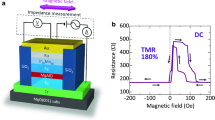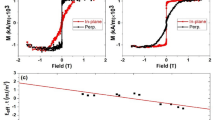Abstract
Magnetic tunnel junctions have become ubiquitous components appearing in magnetic random-access memory, read heads of magnetic disk drives and semiconductor-based spin devices. Inserting a tunnel barrier has been key to achieving spin injection from ferromagnetic (FM) metals into GaAs, but spin injection into Si has remained elusive. We show that Schottky barrier formation leads to a huge conductivity mismatch of the FM tunnel contact and Si, which cannot be solved by the well-known method of adjusting the tunnel barrier thickness. We present a radically different approach for spin-tunnelling resistance control using low-work-function ferromagnets, inserted at the FM/tunnel barrier interface. We demonstrate that in this way the resistance–area (RA) product of FM/Al2O3/Si contacts can be tuned over eight orders of magnitude, while simultaneously maintaining a reasonable tunnel spin polarization. This raises prospects for Si-based spintronics and presents a new category of ferromagnetic materials for spin-tunnel contacts in low-RA-product applications.
This is a preview of subscription content, access via your institution
Access options
Subscribe to this journal
Receive 12 print issues and online access
$259.00 per year
only $21.58 per issue
Buy this article
- Purchase on Springer Link
- Instant access to full article PDF
Prices may be subject to local taxes which are calculated during checkout




Similar content being viewed by others
References
Moodera, J. S., Kinder, L. R., Wong, T. M. & Meservey, R. Large magnetoresistance at room temperature in ferromagnetic thin film tunnel junctions. Phys. Rev. Lett. 74, 3273–3276 (1995).
Miyazaki, T. & Tezuka, N. Giant magnetic tunneling effect in Fe/Al2O3/Fe junction. J. Magn. Magn. Mater. 139, L231–L234 (1995).
Wolf, S. A. et al. Spintronics: a spin-based electronics vision for the future. Science 294, 1488–1495 (2001).
Žutić, I., Fabian, J. & Das Sarma, S. Spintronics: fundamentals and applications. Rev. Mod. Phys. 76, 323–410 (2004).
Parkin, S. S. P. et al. Giant tunnelling magnetoresistance at room temperature with MgO (100) tunnel barriers. Nature Mater. 3, 862–867 (2004).
Yuasa, S., Nagahama, T., Fukushima, A., Suzuki, Y. & Ando, K. Giant room-temperature magnetoresistance in single-crystal Fe/MgO/Fe magnetic tunnel junctions. Nature Mater. 3, 868–871 (2004).
Tehrani, S. et al. Magnetoresistive random access memory using magnetic tunnel junctions. Proc. IEEE 91, 703–714 (2003).
Kikkawa, J. M. & Awschalom, D. D. Lateral drag of spin coherence in gallium arsenide. Nature 397, 139–141 (1999).
Fiederling, R. et al. Injection and detection of a spin-polarized current in a light-emitting diode. Nature 402, 787–790 (1999).
Ohno, Y. et al. Electrical spin injection in a ferromagnetic semiconductor heterostructure. Nature 402, 790–792 (1999).
Datta, S. & Das, B. Electronic analog of the electro-optic modulator. Appl. Phys. Lett. 56, 665–667 (1990).
Sugahara, S. Spin metal-oxide-semiconductor field-effect transistors (spin MOSFETs) for integrated spin electronics. IEE Proc.-Circuits Devices Syst. 152, 355–365 (2005).
Jonker, B. T. Progress toward electrical injection of spin-polarized electrons into semiconductors. Proc. IEEE 91, 727–740 (2003).
Schmidt, G., Ferrand, D., Molenkamp, L. W., Filip, A. T. & van Wees, B. J. Fundamental obstacle for electrical spin injection from a ferromagnetic metal into a diffusive semiconductor. Phys. Rev. B 62, R4790–R4793 (2000).
Rashba, E. I. Theory of electrical spin injection: tunnel contacts as a solution of the conductivity mismatch problem. Phys. Rev. B 62, R16267–R16270 (2000).
Fert, A. & Jaffrès, H. Conditions for efficient spin injection from a ferromagnetic metal into a semiconductor. Phys. Rev. B 64, 184420 (2001).
Motsnyi, V. F. et al. Electrical spin injection in a ferromagnet/tunnel barrier/semiconductor heterostructure. Appl. Phys. Lett. 81, 265–267 (2002).
van ’t Erve, O. M. J. et al. Comparison of Fe/Schottky and Fe/Al2O3 tunnel barrier contacts for electrical spin injection into GaAs. Appl. Phys. Lett. 84, 4334–4336 (2004).
Jiang, X. et al. Highly spin-polarized room-temperature tunnel injector for semiconductor spintronics using MgO(100). Phys. Rev. Lett. 94, 056601 (2005).
Crooker, S. A. et al. Imaging spin transport in lateral ferromagnet/semiconductor structures. Science 309, 2191–2195 (2005).
Van Roy, W., Van Dorpe, P., De Boeck, J. & Borghs, G. Spin injection in LED’s and in unipolar devices. Mater. Sci. Eng. B 126, 155–163 (2006).
Kläsges, R. et al. Formation of a ferromagnetic silicide at the Fe/Si(100) interface. Phys. Rev. B 56, 10801–10804 (1997).
Thompson, R. D., Tsaur, B. Y. & Tu, K. N. Contact reaction between Si and rare earth metals. Appl. Phys. Lett. 38, 535–537 (1981).
Jia, Y. Q., Shi, R. C. & Chou, S. Y. Spin-valve effects in nickel/silicon/nickel junctions. IEEE Trans. Magn. 32, 4707–4709 (1996).
Sze, S. M. Physics of Semiconductor Devices 2nd edn (Wiley, New York, 1981).
Valenzuela, S. O., Monsma, D. J., Marcus, C. M., Narayanamurti, V. & Tinkham, M. Spin polarized tunneling at finite bias. Phys. Rev. Lett. 94, 196601 (2005).
Beadle, W. E., Tsai, J. C. C. & Plummer, R. D. (eds) Quick Reference Manual for Silicon Integrated Circuit Technology (Wiley, New York, 1984).
Kikkawa, J. M. & Awschalom, D. D. Resonant spin amplication in n-type GaAs. Phys. Rev. Lett. 80, 4313–4316 (1998).
Bardeen, J. Surface states and rectification at a metal semiconductor contact. Phys. Rev. 71, 717–727 (1947).
Connelly, D., Faulkner, C., Clifton, P. A. & Grupp, D. E. Fermi-level depinnning for low-barrier Schottky source/drain transistors. Appl. Phys. Lett. 88, 12105 (2006).
Tu, K. N., Thompson, R. D. & Tsauer, B. Y. Low Schottky barrier of rare-earth silicide on n-Si. Appl. Phys. Lett. 38, 626–628 (1981).
Michaelson, H. B. The work function of the elements and its periodicity. J. Appl. Phys. 48, 4729–4733 (1977).
Meservey, R., Paraskevoopoulos, D. & Tedrow, P. M. Tunneling measurements of conduction-electron-spin polarization in heavy rare-earth metals. Phys. Rev. B 22, 1331–1337 (1980).
Julliere, M. Tunneling between ferromagnetic films. Phys. Lett. A 54, 225–226 (1975).
Park, B. G. et al. Temperature dependence of magnetocurrent in a magnetic tunnel transistor. J. Appl. Phys. 98, 103701 (2005).
Uijttewaal, M. A. et al. Interrelation of work function and surface stability: the case of BaAl4 . Chem. Mater. 17, 3879–3882 (2005).
Fan, Y. H. & Brückl, H. Magnetic moment compensation in exchange-biased triayers with antiparallel spin alignment. Appl. Phys. Lett. 83, 3138 (2003).
Acknowledgements
The authors thank R. Keim for the transmission electron microscopy analysis. We acknowledge financial support from NanoImpuls and NanoNed, the nanotechnology network in the Netherlands, the Dutch Technology Foundation (STW) and Sony corporation.
Author information
Authors and Affiliations
Corresponding author
Ethics declarations
Competing interests
The authors declare no competing financial interests.
Supplementary information
Supplementary Information
Supplementary information and supplementary figures S1 and S2
Rights and permissions
About this article
Cite this article
Min, BC., Motohashi, K., Lodder, C. et al. Tunable spin-tunnel contacts to silicon using low-work-function ferromagnets. Nature Mater 5, 817–822 (2006). https://doi.org/10.1038/nmat1736
Received:
Accepted:
Published:
Issue Date:
DOI: https://doi.org/10.1038/nmat1736
This article is cited by
-
Material Study of Co2CrAl Heusler Alloy Magnetic Thin Film and Co2CrAl/n-Si Schottky Junction Device
Journal of Electronic Materials (2020)
-
Achieving large and nonvolatile tunable magnetoresistance in organic spin valves using electronic phase separated manganites
Nature Communications (2019)
-
Nanoscale Conductive Channels in Silicon Whiskers with Nickel Impurity
Nanoscale Research Letters (2017)
-
Spin-Dependent Transport in Fe/GaAs(100)/Fe Vertical Spin-Valves
Scientific Reports (2016)
-
Polarity-tunable magnetic tunnel junctions based on ferromagnetism at oxide heterointerfaces
Nature Communications (2015)



